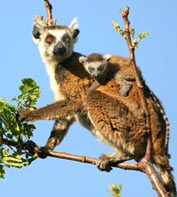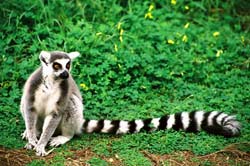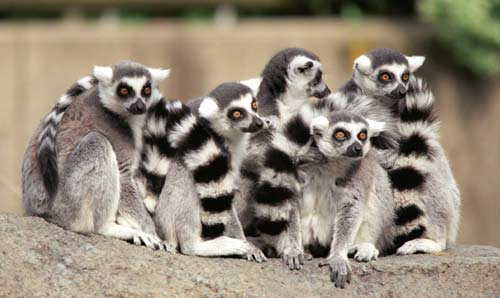|

Only on a few islands: Lemurs are found naturally only on the island of Madagascar (an island off the east coast of Africa) and some smaller surrounding islands, including the Comoros (where it is likely they were introduced by humans). Fossil evidence indicates that they made their way across the ocean after Madagascar broke away from the continent of Africa. While their ancestors were displaced in the rest of the world by monkeys, apes, and other primates, the lemurs were safe from competition on Madagascar and differentiated into a number of species. These range in size from the tiny 30 gram Peters' Mouse Lemur to the 10 kilogram Indri. The larger species have all become extinct since humans settled on Madagascar, and since the early 20th century the largest lemurs reach about 7 kilograms. Typically, the smaller lemurs are active at night (nocturnal), while the larger ones are active during the day (diurnal). the Comoros (where it is likely they were introduced by humans). Fossil evidence indicates that they made their way across the ocean after Madagascar broke away from the continent of Africa. While their ancestors were displaced in the rest of the world by monkeys, apes, and other primates, the lemurs were safe from competition on Madagascar and differentiated into a number of species. These range in size from the tiny 30 gram Peters' Mouse Lemur to the 10 kilogram Indri. The larger species have all become extinct since humans settled on Madagascar, and since the early 20th century the largest lemurs reach about 7 kilograms. Typically, the smaller lemurs are active at night (nocturnal), while the larger ones are active during the day (diurnal).

The smaller types are generally omnivores, eating a variety of fruits, flowers and leaves (and sometimes nectar) as well as insects, spiders and small vertebrates. The remainder of the lemurs, the lemuroids are primarily herbivores, although some species supplement their diet with insects.
 
Mom and dad chauffers: A typical and maximum frequency of births is one offspring per female per year, with initial year infant mortality at about fifty percent. Births normally occur in October and November (early summer in this southern hemisphere habitat). The young use their prehensile instincts in order to attach to the mother and father alternately for the first 33 to 37 days of life. At this point the mother often refuses further transport services, whilst the father may continue to provide such for another nine weeks.

Ring-tailed lemurs (Lemur catta) have mostly gray (some brown) fur on most of their bodies, with accents of white fur on their stomach, ears and faces. Most distinctive is the eye patches around their eyes and their long, black white striped tail that helps them in balancing when jumping through the trees. They are only found in Madagascar. 
Perfume wars: Lemurs have scent glands on their wrists and upper arms that they use to mark territory. Both male and females have these glands. When males get into aggressive interactions they also rub the glands onto their tails and throw their scent around through the fight.
Daily life: These lemurs are diurnal and do most activity in the morning and evening. The rest of the day is used for resting and grooming. They use their claws to groom each other. They spend time in the trees and the ground. The groups are between 3 and 20 lemurs (usually females and offspring), and at the end of the day to collect the group they will make calls to each other. They communicate often through calls, which go from chirps to howles to shrieks and clicks. 
Sounds like a cat!: When they are calling each other for sleeping, it sounds like the meow of a cat. They sleep together in the group, using their tails curled around them for warmth.
The Red-bellied Lemur (Eulemur rubriventer) is a medium sized prosimian with a luxuriant chestnut brown coat. This lemur is endemic to eastern Madagascan  rainforests and is distinguished by patches of white skin below the eyes, giving rise to a "teardrop" effect, particularly conspicuous in the male. rainforests and is distinguished by patches of white skin below the eyes, giving rise to a "teardrop" effect, particularly conspicuous in the male.
Night and day crawlers: The Red-bellied Lemur aggregates in monogamous groups ranging from two to ten individuals. It is one of the few lemurs to be recognized as cathemeral, having both diurnal and nocturnal activity patterns. The home range is estimated to be 25 to 35 acres (10 to 14 ha) with a typical density of five animals per acre. Groups are typically cohesive as they move within their home range, foraging on over thirty species of plants. Considered by some to be a frugivore, it also feeds on leaves, nectar and flowers of many plant species; this lemur is believed to be a useful and efficient seed disperser. As shown here, the four families of lemurs are split into two superfamilies. The Cheirogaleidae have a pedal structure, similar to the other strepsirrhine families and the haplorrhines, suggesting they split off from the other lemurs first. As such, the Cheirogaleoidea are a sister clade to the Lemuroidea.
- ORDER PRIMATES
- Suborder Strepsirrhini: non-tarsier prosimians
- Infraorder Lemuriformes
- Superfamily Cheirogaleoidea
- Family Cheirogaleidae: dwarf and mouse lemurs
- Superfamily Lemuroidea
- Family Lemuridae: lemurs
- Family Lepilemuridae: sportive lemurs
- Family Indriidae: woolly lemurs and allies
- Infraorder Chiromyiformes
- Infraorder Lorisiformes
- Suborder Haplorrhini: tarsiers, monkeys and apes
Lemur | Loris | Tarsier
Primates| Apes| Monkeys| Prosimians
All text is available under the terms
of the GNU Free Documentation License |